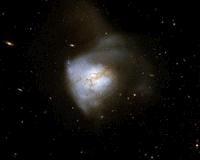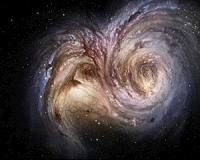|
 Extracting Information From Starlight
Extracting Information From StarlightGreenbelt MD (SPX) Mar 31, 2010 The cosmos is filled with stars. However, the closest star beyond the Sun is so far away, that it would take the fastest spacecraft 75,000 years to reach it. Astronomers can't study the cosmos by sending probes to gather information about other stars, as we do with our own Sun and its planets. Fortunately they don't have to. The information comes to us at the speed of light! The light of stars is produced by atoms and molecules that encode, in the starlight itself, key science information about th ... read more |
. |
|
|
Free Space, Earth, Energy And Military Newsletters - Delivered Daily |
| . | . |
| .. |
Helium Rain On Jupiter Explains Lack Of Neon In Atmosphere Berkeley CA (SPX) Mar 23, 2010
Berkeley CA (SPX) Mar 23, 2010On Earth, helium is a gas used to float balloons, as in the movie "Up." In the interior of Jupiter, however, conditions are so strange that, according to predictions by University of California, Berkeley, scientists, helium condenses into droplets and falls like rain. Helium rain was earlier proposed to explain the excessive brightness of Saturn, a gas giant like Jupiter, but one-third the ... more Early Galaxy Went Through 'Teenage Growth Spurt'  London, UK (SPX) Mar 23, 2010
London, UK (SPX) Mar 23, 2010Scientists Have Found A Massive Galaxy In The Early Universe Creating Stars Like Our Sun Up To 100 Times Faster Than The Modern-Day Milky Way. The Team Of International Researchers, Led By Durham University Scientist And Royal Astronomical Society Norman Lockyer Fellow Dr. Mark Swinbank, Described The Finding As Like Seeing "A Teenager Going Through A Growth Spurt". Due To The Amount ... more Cold Fusion Moves Closer To Mainstream Acceptance  San Francisco CA (SPX) Mar 22, 2010
San Francisco CA (SPX) Mar 22, 2010A potential new energy source so controversial that people once regarded it as junk science is moving closer to acceptance by the mainstream scientific community. That's the conclusion of the organizer of one of the largest scientific sessions on the topic - "cold fusion" - being held here for the next two days in the Moscone Center during the 239th National Meeting of the American Chemical Soci ... more |
.. |
 Sharpest View Ever Of Distant Star Factories  Early Galaxy Went Through Teenage Growth Spurt  Instant online solar energy quotes Solar Energy Solutions from ABC Solar |
.. |
|
|
Free Space, Earth, Energy And Military Newsletters - Delivered Daily |
|
|
. |
 Atom smasher cranks up to record energy levels: CERN
Atom smasher cranks up to record energy levels: CERNGeneva (AFP) March 19, 2010 The world's most powerful atom smasher has been brought up to a record energy level, the European Organisation for Nuclear Research said Friday, in readiness for collisions that could generate new discoveries in particle physics. "At just after 5.20 this morning, two 3.5 TeV proton beams successfully circulated in the Large Hadron Collider for the first time," said CERN in a statement. "This is the highest energy yet achieved in a particle accelerator, and an important step on the way to the sta ... read more |
| The contents herein, unless otherwise known to be public domain, are Copyright 1995-2010 - SpaceDaily. AFP and UPI Wire Stories are copyright Agence France-Presse and United Press International. ESA Portal Reports are copyright European Space Agency. All NASA sourced material is public domain. Additional copyrights may apply in whole or part to other bona fide parties. Advertising does not imply endorsement, agreement or approval of any opinions, statements or information provided by SpaceDaily on any web page published or hosted by SpaceDaily. Privacy statement |
| Previous Issues | Mar 30 | Mar 29 | Mar 26 | Mar 25 | Mar 24 |